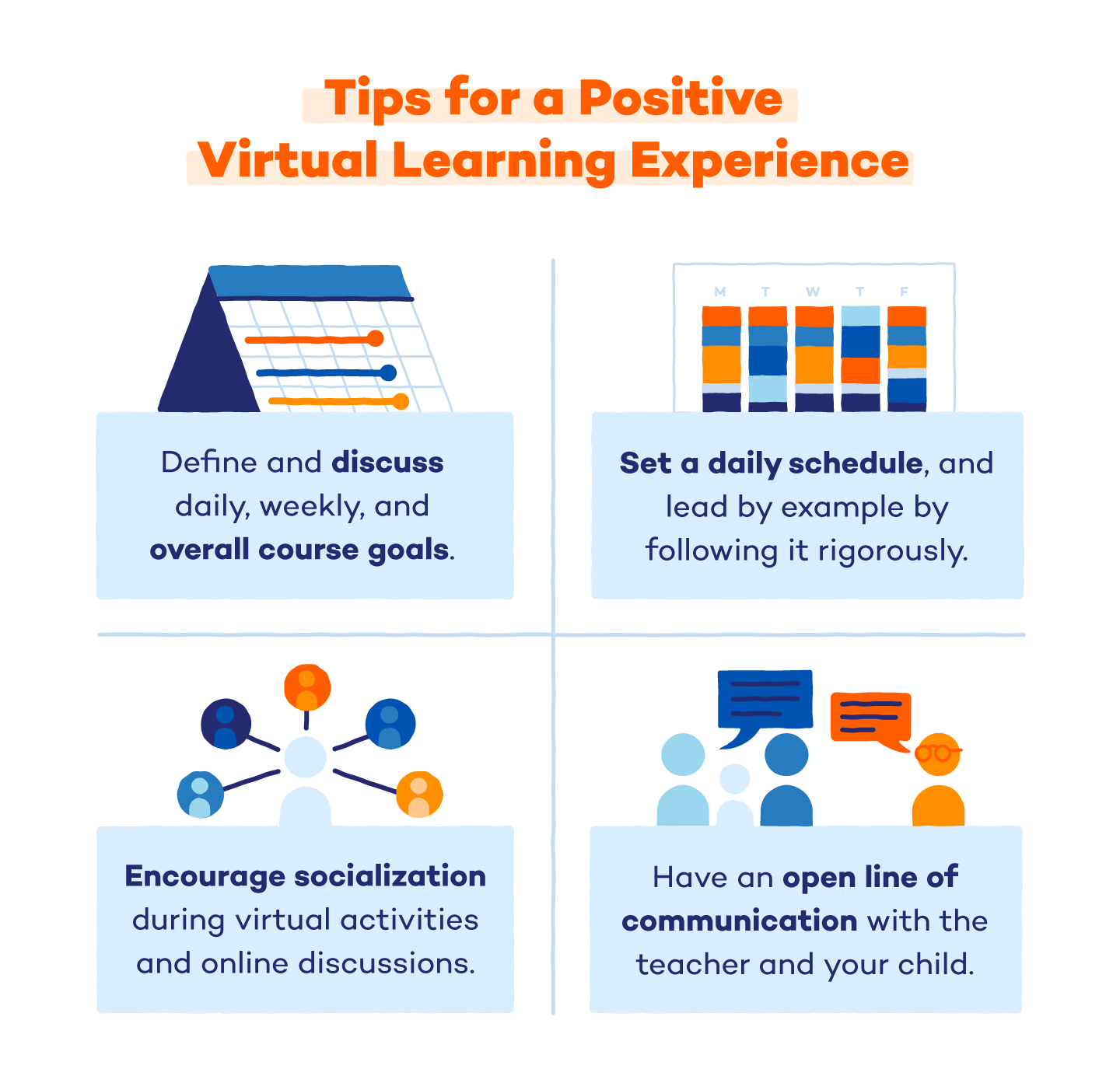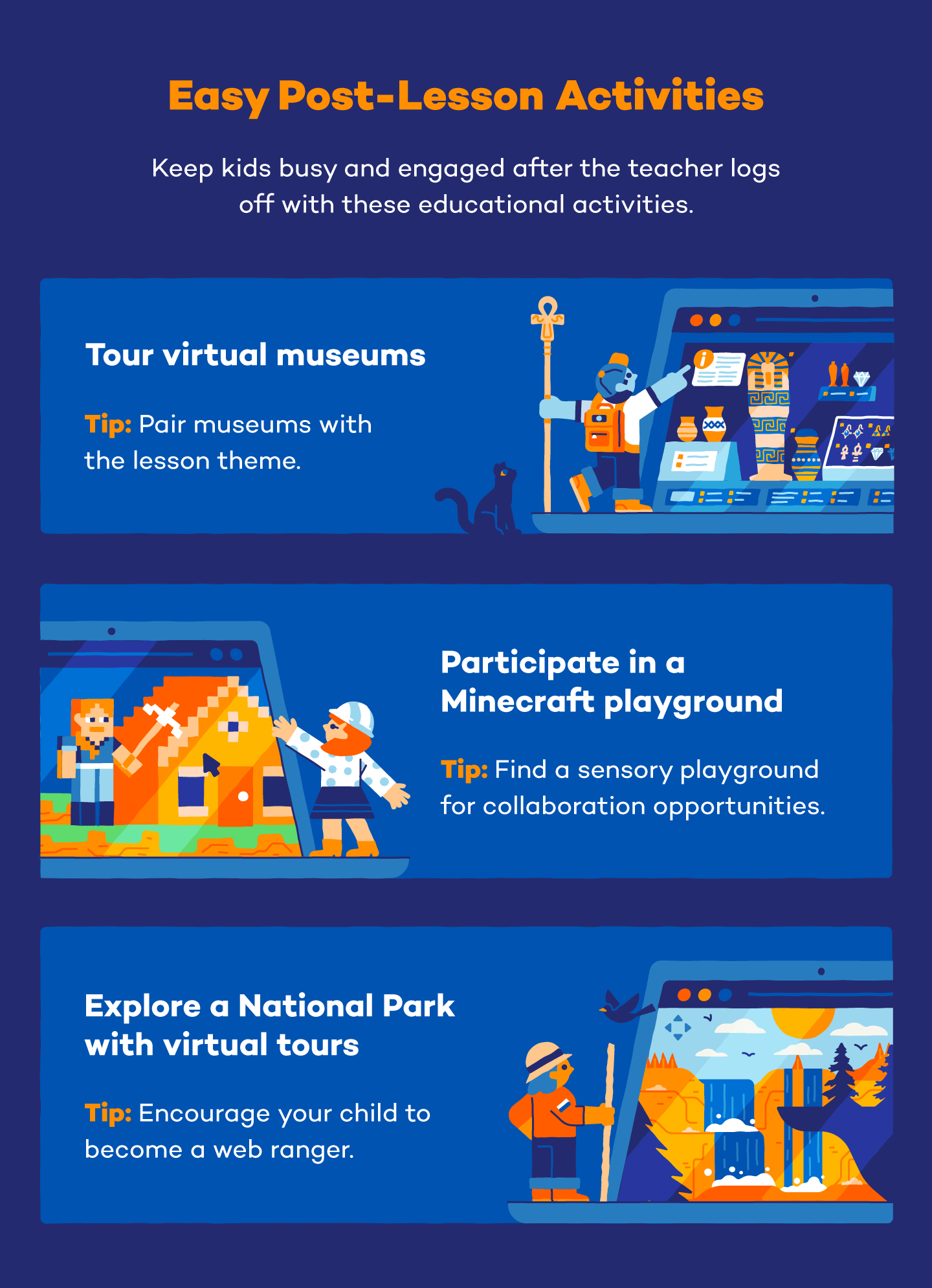Before the effects of COVID-19 began a virtual learning standard for students across the world, 49% of learners said they had taken a course online in the last year, according to Statista. With government-mandated school closures and the influx of remote work, the responsibility to create a successful learning environment is on the shoulders of parents more than ever before.
The academic progress of children has to be carefully monitored as the landscape of learning dramatically shifts. By staying attuned to the lesson plans of teachers, parents can begin to recognize the signs of their child’s educational growth on their own. But how do you create the balance of successful education for your children, while managing an entire workload and daily tasks? Set parental controls on all edtech, create a line of open communication with your child and their teacher, recognize the signs of struggling with material or general online learning, and help create an effective learning schedule.
- Virtual Learning Benefits
- Types of Virtual Learning
- Work from Home and Virtual Learning
- How to Measure Engagement
- Signs of Virtual Learning Challenges
- Additional Resources
Virtual Learning Benefits
Many objections to virtual learning stem from the fear of de-socialization and decreased learning. In theory, however, the benefits of e-learning far outweigh the challenges, and offer just as many, if not more, perks of an in-person classroom. Advocates highlight the wider variety of subjects and the ability to make-up previously failed courses while working at a personalized, often slower, pace.
Virtual learning benefits include:
- More cost-effective than traditional schools.
- Immediate test feedback.
- Wider variety of subjects than a standard in-person course.
- More personalized lesson plans.
- Greater schedule flexibility.
- Fewer learning approaches with maximized performance impact.
- Ease of accommodating special education needs.
- Increased parental involvement in academics.
Types of Virtual Learning
Virtual learning can either be partly or completely done online. Lessons can range from live lessons via video to pre-recorded versions. Additionally, virtual learning can employ the use of applications and tools online to supplement in-class instruction.
Different types of virtual learning include:
- Fully virtual classroom: This model is a synchronous online course where students and teachers attend live lessons and group interactions.
- Asynchronous online course: Sometimes called a flex virtual classroom, students are able to leave and attend class at any time. All academics are pre-recorded and planned so students have the most flexibility to complete the material with this model.
- Rotation model: Also called blended learning or an enriched virtual classroom, in this model, students split their time learning remotely and attending a traditional classroom.
Managing Working from Home and Virtual Learning
Oftentimes, working from home deserves an adjustment period of its own. When this shift happens on top of the required virtual learning mandates, there is a higher chance of failure without the proper set up.

Before beginning coursework or logging on for the workday, it’s important to define two dedicated spaces for both classroom and work stations. Dedicated workspaces increase the chance of productivity, and the ability to separate work and home life. While preparing, expect technical difficulties during the adjustment period, and plan for them by allowing buffer time in the school and work schedules.
Set a Schedule
Creating a routine that works for everyone is vital for a productive and satisfying work day. Just as you would for a telecommuting job, define a schedule. Make sure hygiene practices are standard, and consider adding an alternative commute. This could be as simple as walking around the block before starting the work day.
Schedule your child’s day in at least one-hour blocks so you have plenty of time for heads-down work. Encourage them to take breaks outside with you and stretch throughout the day. Just as important as getting a proper start to the day, it’s just as important to set a hard stop for healthy boundaries.
Sample student schedule:
- (7:30am) Walk around the block
- (8:00am) Breakfast
- (8:30am) Class begins
- (10:30am) Stretch break
- (11:00am) Dedicated self-study
- (12:00pm) Lunch
- (12:30) Online lessons
- (2:00pm) Walk around the block
- (2:15pm) Dedicated self-study
- (3:15pm) Rotating activity
Sample work from home schedule:
- (7:30am) Walk around the block
- (8:00am) Breakfast
- (8:30am) Touch base with team
- (9:00am) Tasks
- (10:30am) Stretch break
- (11:00am) Assist with self-study
- (12:00pm) Lunch
- (12:30) Tasks
- (2:00pm) Walk around the block
- (2:15pm) Emails
- (3:00pm) Assist with daily activity
- (3:15pm) Set tomorrow’s schedule
Create Assignments and Due Dates
Before beginning the work, define goals for your child. Accompany those requirements with a rewards system. These needs to be discussed and can adjust as lessons progress. Reiterate how online lesson plans are just as important as in-class activities. Stress important due dates and consider making strict at-home due dates for self-study and virtual activities.
Plan Post-Lesson Activities
It’s not uncommon for a work day to last longer than the average day at school. To avoid the post-class boredom, incentivize your little one’s progress with fun activities. Consider milestone activities that are extra special when test scores jump, or an assignment gets a high mark.

Consider these ideas to continue the learning well after the teacher logs off:
- Tour virtual museums
- Participate in Minecraft playground
- Enlist specialized STEM learning activities
- Explore a National Park with virtual tours
Child Engagement and Virtual Learning
The downfalls of virtual learning can be the feeling of isolation and de-socialisation. A key to ensuring the quality of online education lies in your child’s engagement. By nurturing online relationships and interactions, mentoring when applicable, staying organized and instructing when needed, inspiring continual motivation is simple.
How to Measure Virtual Learning Engagement
Oftentimes in virtual learning environments, teachers encourage parents to get involved more than is typical in a standard school setting. Open communication with your child and their instructor is an integral part of success in an online program.
- Discuss teaching goals: Have a one-on-one with the instructor a few times throughout the curriculum and gauge where your child is compared to the rest of the students.
- Talk to your child: Encourage open communication and ask your child how they’re feeling about the lessons, and their performance, frequently.
- Monitor grades: Note any significant drops or changes in grades. Identify the problem when applicable, and create a plan of action necessary.
- Notice social shifts: If your child is withdrawn, or has a lack of interest for things that were normally of interest, have a conversation first, and bring in a counselor if necessary.
Utilize Virtual Learning Tools Safely
Edtech has boomed in and out of the classroom in recent years. So much so, that it’s often difficult to distinguish between quality applications and unsafe ones. Luckily, school districts have a list of approved tools you can reference throughout the course of the curriculum.
To ensure your child’s data privacy online, check that non pre-approved edtech adheres to the following:
- Only use educational apps: Application is used for educational purposes, not consumer. Consumer technology typically does not employ stringent data usage policies.
- Review the privacy policy: There is a privacy policy in place that confirms data will be used for in-app performance only, and will not be sold to any third party sources.
- Check website for encryption: Website has an “s” in the https portion of the web URL. This informs the user that the website is encrypted.
Signs Your Child is Struggling with Virtual Learning
A flexible mindset and positive attitude towards virtual learning will help create a successful transition. Although there will be an adjustment period, and things will likely not go as planned every step of the way, it’s important to keep an open mind and line of communication.
Online learning presents the opportunity for out-of-the box thinking, and creative solutions. If your child is struggling with the curriculum, analyze and adapt. The beauty of virtual learning is the personalization aspect. So, if you see these signs of virtual learning challenges for your child, take the opportunity to gain insight and adjust the course accordingly.
Late Assignments
- The sign: Late assignments.
- What to do: If you’re getting notifications of late work, find out if there is technology your child is lacking to complete the task, or they need supervision to complete their work. Create deadlines and follow-up on them appropriately.

Poor Time Management
- The sign: Poor time management.
- What to do: Sit with your child each night and go through the tasks that were completed throughout the day. Make a plan for the next day with a set schedule, if needed.

Not Asking for Help
- The sign: Not asking for help.
- What to do: Find out what your child’s favorite mode of communication is: email, phone, or video chat. Allow them to send you drafts of their question, or practice with you before they discuss with the teacher or other students.

Lack of Motivation
- The sign: The lack of motivation.
- What to do: If your child is not motivated by grades or course completion, consider using outside rewards for passing grades and notable work.

Disinterest in Activities
- The sign: Uninterested in outside activities and extracurriculars.
- What to do: Have a conversation with your child. Find out if there is a specific reason, or person, your child doesn’t want to see. If the disinterest persits, it may be time to bring in a counselor.
Additional Resources
The world of virtual learning comes with endless possibilities when it comes to teaching and utilizing educational resources. Use the below to further your understanding and better your at-home edtech practices.
- UNESCO Distance Learning Solutions
- Discovery Education and Virtual Learning
- California Department of Education
Virtual learning is a chance to personalize the classroom beyond after-hours. By assisting your child in becoming a successful self-motivated student, they’ll reap the benefits of creative problem solving, a wider knowledge base, and a flexible schedule.
Sources: Global Workplace Analytics | Research Gate







